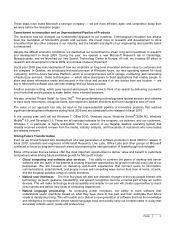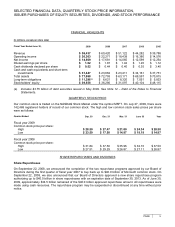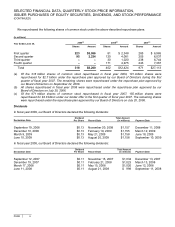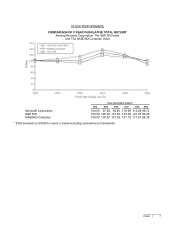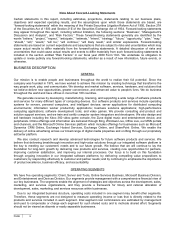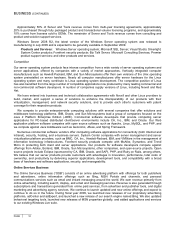Microsoft 2009 Annual Report Download - page 2
Download and view the complete annual report
Please find page 2 of the 2009 Microsoft annual report below. You can navigate through the pages in the report by either clicking on the pages listed below, or by using the keyword search tool below to find specific information within the annual report.
PAGE 2
To our shareholders, customers, partners, and employees:
A worldwide economic recession that created the most difficult business environment since the Great Depression
made fiscal 2009 a challenging year for Microsoft Corp. But thanks to our fiscal strength and prudent approach to
investment, a strong pipeline of products, and a renewed focus on efficiency, we responded to the changing
economic environment with speed and success. Fiscal 2009 was also a year in which the company made important
progress in key areas of product development and technology innovation that position us for strong growth in the
years ahead.
The global recession had a major impact on the financial performance of companies around the world in virtually
every industry in 2009, and Microsoft was no exception. As consumers and businesses reset their spending at lower
levels, PC sales and corporate IT investments fell. As a result, Microsoft saw its first-ever drop in annual revenue,
from $60.4 billion in fiscal 2008 to $58.4 billion in fiscal 2009, a decline of 3 percent. Operating income was $20.4
billion, down 9 percent. Earnings per share fell 13 percent to $1.62.
Despite the difficult economic conditions, we introduced an impressive range of innovative new software to the
marketplace. Fiscal 2009 saw the successful launch of key products including Microsoft® SQL Server 2008,
Microsoft Internet Explorer® 8, and Bing, the newest version of our Web search technology. With Silverlight™ 2,
Microsoft Business Productivity Online Suite, Microsoft Exchange Online, and Microsoft SharePoint® Online we
strengthened our position as a leader in software plus services and cloud computing. New and updated offerings for
business customers included Windows® Small Business Server 2008, Windows Essential Business Server 2008,
and Microsoft BizTalk® Server 2009. We also delivered pioneering new products that are fundamentally changing
the way people use digital technology, including Microsoft Photosynth™, Microsoft Robotics Developer Studio 2008,
and Microsoft Amalga™ Life Sciences 2009.
During fiscal 2009, we made a number of strategic acquisitions, including the interactive online gaming company
BigPark; DATAllegro, a provider of breakthrough data warehouse technologies; and Zoomix, which develops
software that automates the delivery and synchronization of enterprise data. We also acquired Powerset, a pioneer
of the use of natural language processing in online search, and Greenfield Online, a leader in comparison shopping
technology.
A Strong Response to a Difficult Economic Climate
The global recession created difficult challenges for Microsoft, and for our industry as a whole. But it also created
significant opportunities.
Because we offer a wide range of affordable, high-quality products today that enable companies to improve
productivity and reduce costs, Microsoft is well-positioned to weather the economic downturn and gain market share.
As the global economy begins to recover, this will create new opportunities to increase revenue.
In addition, employees and company leaders responded to the economic downturn by sharpening Microsoft’s focus
on our most important opportunities for growth now and in the future, and on finding opportunities to cut costs and
use resources more effectively. All told, we reduced expenses by more than $3 billion compared with our original
fiscal 2009 plan and we remain committed to controlling costs in fiscal 2010.
During fiscal 2009, we also made important adjustments to our cost structure through strategic job eliminations. The
decision to eliminate up to 5,000 jobs was very difficult, but it was the right move because it has enabled us to focus
resources where they can deliver the greatest results for the company. And we continue to recruit and hire the best
talent from around the globe.
The company’s fiscal strength was an important factor in Microsoft’s ability to successfully weather the difficult
financial markets that prevailed for most of fiscal 2009. Thanks to our excellent financial position, we announced a
new $40 billion program in early fiscal 2009 to repurchase shares of our stock and increased the quarterly dividend.
We also returned nearly $14 billion to shareholders through stock buybacks and dividends during the fiscal year.
We also took advantage of favorable market conditions in fiscal 2009 to authorize a $3.75 billion debt offering. As
part of the debt authorization, Microsoft received a AAA credit rating from Standard & Poor’s, becoming the first U.S.
corporation in a decade to be assigned S&P’s highest rating.



